How to install a faucet in the kitchen: step-by-step instructions for the work
A kitchen is one of the rooms in a house or apartment that is used in intensive mode.The kitchen faucet is subject to significant daily stress, so it is advisable to choose a quality product.
After the choice is made, you need to figure out how to install the faucet in the kitchen, fulfilling all the engineering requirements for installation. Read about how to do this correctly in our material.
The content of the article:
What to consider before starting installation?
First you need to decide on the installation method: the mixer can be mounted on a countertop, sink body or on a wall. It is necessary to outline in advance the routes for the location of hot and cold water pipes.
In this case, the connection points must be accessible in case of subsequent repairs or maintenance. If you plan to install a filter, then the place for its installation must be provided in advance.
Several recommendations for choosing a mixer
The mixer is invariably operated in tandem with the sink, so when choosing a product you need to take into account its size and depth, as well as:
- distance between the wall and the hole for the mixer;
- diameter of the hole for the mixer insert;
- drain location points.
In this case, the mixer must be of sufficient length so that the end spout after installation, it fell on the center of the sink or sink.
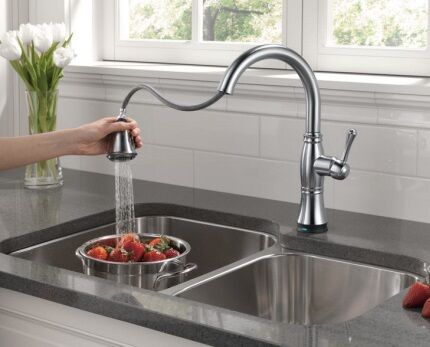
Heights spout there should be enough to place a tall pan under the tap. But don’t go to extremes and buy a faucet that is too tall. Otherwise, splashes are created that fly outside the sink.
Another important parameter regarding the geometry of the mixer is the rotation angle. If the sink is close to the wall, then it is enough to install a mixer with a rotation angle of up to 90 degrees. If you use a sink with two bowls, then you need to pay attention to models with a rotation angle of 180-360 degrees.
Variety of styles of plumbing fixtures
Having finished with the technical part, you need to decide on the appearance. Today, the choice of faucet styles is so huge that even the most spoiled owner will be able to find a model to suit his taste.
Classic, hi-tech, loft, minimalism, chopped and streamlined shapes, chrome, copper or black - you can choose an option for any kitchen.
At the same time, unfortunately, the rule applies: the more expensive, the better - especially true for plumbing fixtures and faucets in particular. There is a limit to everything, but high-quality plumbing fixtures made in Europe are an order of magnitude more expensive than domestically made products.
Determining the optimal design
When choosing, you need to take into account the design features of the mixers. The most practical models are single-lever ones, in which the flow intensity and temperature can be adjusted using one handle. Models with two valves are less practical, but go well with the classic kitchen interior.
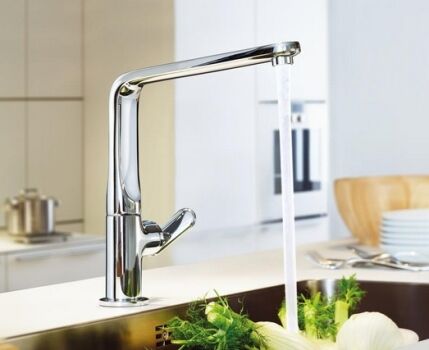
Manufacturers also produce contactless products that are equipped with a motion sensor. When you raise your hands, the sensor is triggered and the mixer starts dispensing water.
For the kitchen, this is also not the most practical option, since you often have to change the temperature and collect water in containers.
Prices for faucets depend on the type of alloy used and the brand of the manufacturer. The cheapest models are made of silumin, have a beautiful appearance, but quickly wear out and become unusable. Silumin and other cheap alloys crumble and crack quite quickly.
The highest quality products are made from brass. A layer of nickel, aluminum or chrome is applied to the surface to give the faucet a beautiful appearance. Chrome plated products are the most wear-resistant. We recommend that you read our other article, in which we described in detail the features of the choice kitchen faucets.
Mixer installation instructions
Brief step-by-step instructions will help you quickly and correctly install the plumbing fixture in place and allow you to avoid common mistakes.
Carrying out the preparatory stage
Before starting any work, you need to turn off the water supply to the house/apartment from the central riser. If this is not done, water under pressure will create a lot of trouble when unscrewing the connections. Next, you need to open the mixer so that the remaining water flows out of the system.
You also need to stock up on all consumables and tools.
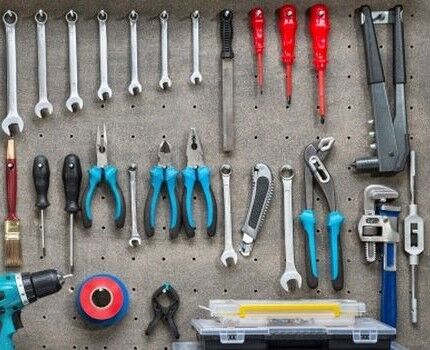
It is advisable to read the instructions for the mixer before starting work. To perform most of the work, you do not need to look for any specialized devices. The following set of materials and tools will be sufficient:
- Phillips screwdriver;
- flat screwdriver;
- adjustable wrench;
- flashlight;
- sandpaper;
- a set of flexible hoses (if they are not included with the mixer);
- water container;
- WD-40 aerosol;
- tow;
- socket wrenches.
It is better to replace the liner to the old mixer with a new one. It is inexpensive, and besides, it will be the key to the most airtight and durable connections. Read about how to choose and install eyeliner Further.
Dismantling the old device
If you are making repairs, then first you need to dismantle the old mixer. So, having completed all the preparatory procedures, you need to find the connection points of the mixer with the water pipes.Next you need to find the places where the faucet is attached to the sink.
Using an adjustable wrench, disconnect the flexible connection of the mixer and the pipe. It is important not to forget to replace the container in time, as residual water may leak from the water supply.
If the sink is overhead, then it must be carefully removed. Before doing this, you need to disconnect the lower part of the siphon. Only after this can the sink be removed.
The sink should be turned over so that it is convenient to unscrew the faucet mount. Rust could have accumulated in these places, and the joints could stick to each other, so they should be treated with WD-40.
After waiting 10-15 minutes, you can try to unscrew the connection nuts using an adjustable wrench. First you need to slightly loosen the nuts that are on the threaded pin.
Now, using a screwdriver, you need to unscrew the threaded pin. During this operation, you need to hold the mixer with your hand so that it does not fall.
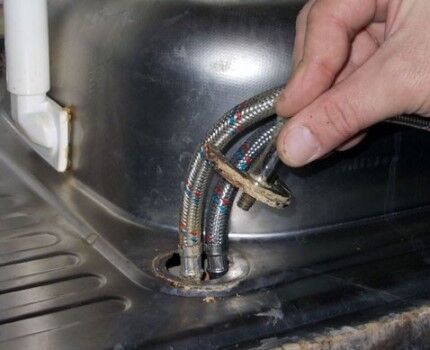
Next, the mixer is removed along with the clamp. If it was decided to replace the old hoses with new ones, then they can be freely pulled out along with the mixer through the mounting hole.
The mounting hole itself must be cleaned of accumulated dirt. You can recycle your old faucet and start working on installation of a new crane.
Installing a new appliance in the sink
Before installation single lever mixer in the kitchen, you need to attach an eyeliner to it. It is necessary to wrap tow around all connections - with its help you can seal the system as much as possible.
The tow is wound onto the threads of flexible hoses before connecting them to the mixer. You can add a drop of drying oil to the tow so that when twisting it does not stick to the base of the thread.
The mixer comes with a decorative ring gasket. It is made of metal and has a rubber layer. It is necessary to ensure that the rubber insert is installed exactly in the designated grooves of the ring. Thread the ring through the hose to the base of the faucet.
Now you can install the mixer on the sink by pulling flexible hoses through the mounting hole. It will be useful to have someone from outside to hold the faucet while you screw it to the sink. You need to thread a spacer through the liner.
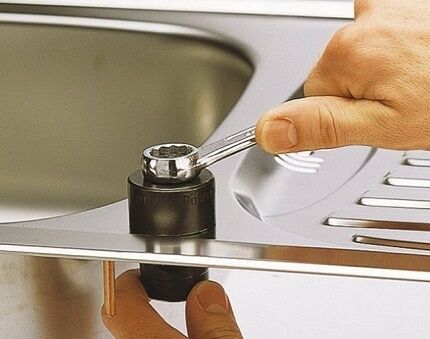
Next screw in threaded pins through the spacer (pressure plate) into the base of the mixer, attach nuts to the pins. Now your partner should secure the faucet in position so that you can tighten the nuts using a socket wrench (in most cases this is an 11 wrench).
The mixer has now assumed the position in which it will be used in the future. Before the final efforts to tighten the nuts, you need to make sure that all sealing gaskets have not moved and are in their places.
The sink can be installed in place, and then the connections can be connected to the appropriate fittings in the plumbing system. The pipe connections must be cleaned with sandpaper and a layer of winding applied. This can be linen thread or a roll of waterproof tape sealant.
If you choose a tape, then it must be wound overlapping.If you decide to resort to using flax thread, then you need to lubricate the threads with paste sealant and only then wind the thread.
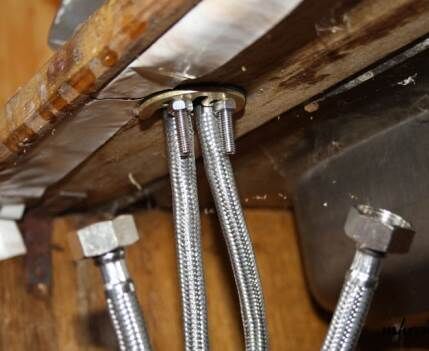
We join siphon for sinkto begin testing your plumbing. After this, you can open the water supply from the riser and check all connections under maximum pressure.
If water drips in, you need to tighten the threaded connections tighter and test everything again.
Taking into account technological nuances
Now you know how to install and connect a faucet in the kitchen, but there are some difficulties that may prevent you from performing a quality installation. There are situations when it is impossible to unscrew old flexible hoses, because the joints literally stick to each other.
There are also cases when you need to adjust the diameter of the mortise hole or install it on a difficult surface, for example, on a table top.
In such cases it will be necessary jigsaw, with which you need to cut a hole in the tabletop. If the condition of the pipes and their distribution is deplorable, then it is necessary to change and modify the entire water supply system. In such cases, you can seek the help of a specialist or delve deeper into studying the issue of installing plumbing systems.
Photo guides for DIY plumbers
Let's look at two options for installing kitchen faucets with different types of fastening. In the first case, we will fix the device with a nut, in the second - with two studs.
Since in designs with a clamping nut the installation of the mixer is usually hampered by a somewhat long base, let's start with the direct installation of the mixer:
The second option involves mounting the device using studs. Such designs do not allow for proper tightening of flexible hoses after fixing the mixer to the countertop or sink. Therefore, we will first screw them in and then fix the device:
When installing mixers of both designs, it is important to monitor the position of the large and small seals. They must completely fill the space between the parts. Even the smallest gaps are unacceptable.
Installing a faucet into a countertop
For this method, in addition to the devices described above, you will need the following:
- electric jigsaw;
- drill;
- set of drills.
The installation method is practically no different from the previous one. Only in this case there is no need to dismantle the sink.Installing a faucet into a countertop requires making a hole in the countertop itself.
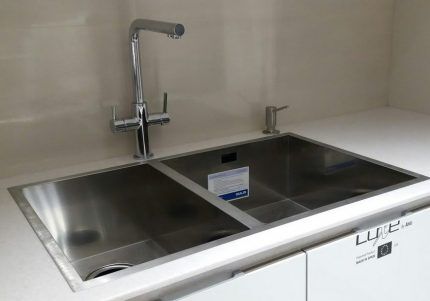
The choice of location for the hole should be based on practical recommendations:
- water should not fall on the countertop while using the mixer;
- the valves/lever should be comfortable to use;
- The spout should be positioned relative to the sink according to the recommendations presented at the beginning of the article.
First you need to make markings along the contour of the base of the mixer using a pencil. Using a drill, drill four holes in the corners of the drawn perimeter.
Then use a jigsaw to cut a hole through which you can pull the liner and insert the threaded pins. The cut needs to be cleared of sawdust and the edges cleaned with sandpaper.
It is important not to make the hole too large. Otherwise, the size of the clamping ring may not be enough to cover the entire hole. Further, the sequence of actions remains the same as when installing the mixer on the sink.
Mounting the device on a wall
Installing a faucet into the wall is a rather original solution for the kitchen interior. In this case, the crane will occupy a minimum of working space. Appropriate cutouts are first made in the tile or wall through which the connection will be made.
This type of installation looks quite aesthetically pleasing. In some cases, the pipes from the wall are brought outside, but this option is detrimental to the interior of the kitchen; it is better to hide all the pipes behind the wall.
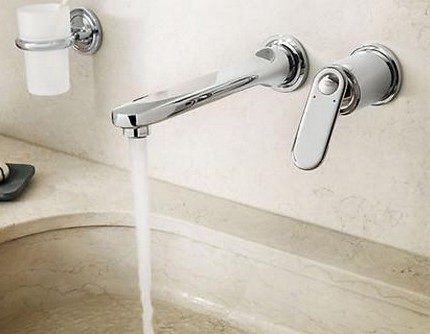
Installing the mixer on the wall requires appropriate water supply with the elements for connection to the outside. The connection method is the same for iron, plastic, copper or metal-plastic pipes except for the use of adapters and fittings.
The connection method is also not affected by the type of mixer (valve, cartridges, etc.). A prerequisite is the selection of a wall-mounted mixer, the design of which involves installation in the wall.
For installation on iron pipes, tees and angles are used. If the axes of the connectors for connecting the mixer coincide with the axes of the pipes, then it is enough to use couplings. To connect to other types of pipes, special fitting, which are also called water sockets.
Features of wall-mounted mixers
These models can be mounted at any height. Faucets are available with flexible and rigid spouts. Flexible ones have many position variations that allow you to perform any task in the kitchen. Products with a rigid spout require limited travel and rotation of the mixer.
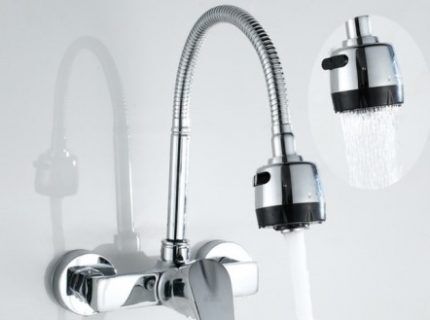
For most kitchens, wall-mounted models are a fairly convenient and practical solution.
Connection sequence
First you need to screw on the eccentrics that connect the mixer to the pipes. To avoid increased condensation formation, the distance between the pipe axes should be 150 mm.
Majority wall mixers are produced with exactly this distance between the eccentrics. You need to wrap tow (linen or synthetic) around the threads.

Next, screw the faucet nuts onto the eccentrics and install the decorative screen (overlay). It is carefully screwed on by hand, as it must fit snugly to the surface of the wall.
If the gap is no more than 5 mm, then you can disconnect the mixer and cut the eccentrics to the appropriate length. The decorative panel hides all imperfections on the wall.
Next, you should install the gaskets, which are included with the mixer and can be made of silicone, paronite, rubber and other polymer materials.
Gaskets are inserted into the housing nuts to ensure a tight fit. fit to eccentrics. For maximum density, there should be no cracks on the eccentric. An uneven cut surface can be sanded with sandpaper.
The last stage is tightening the nuts: first with your hands, and when your own efforts are no longer enough, you need to tighten the connections with an adjustable wrench. The efforts should not be excessive so as not to damage the threads.
Conclusions and useful video on the topic
Several useful video tips will help you install the mixer quickly and without errors.
Professional advice from GROHE specialists:
Installation and connection of a single lever device:
Now you know how to install a sanitary faucet in the kitchen or bathroom. Regardless of the type of installation, this is not too difficult to do.
It is enough to have with you the necessary set of tools, consumables and theoretical knowledge.Of course, the task can be complicated by old, worn-out pipes or the need to modify the plumbing.
Have you repeatedly encountered the installation of faucets and can you give valuable advice to help home craftsmen? Or are you planning to install a faucet, but are not sure that you are doing everything correctly? Please leave your comments and ask questions about the topic of the article in the block below.




Am I the only one who always breaks the taps in my house? As soon as I install it, a couple of months will pass, and again I need to dig into it and change something - either gaskets or connections begin to fly off. And I can’t understand why this is so: either my hands are in the wrong place, or I just always buy low-quality faucets. So I still don’t understand how to check the displacement of the sealing gaskets, maybe this is the problem with me?
Same thing as you. It was dripping tediously into the sink, they changed the gaskets, tightened everything up, not even a month had passed, yesterday it started dripping again...
Hello. You're not the only one. This is a problem with inexpensive faucets for everyone. We didn’t bother with aesthetics and made the faucets out of plastic. I would say that they are practically “eternal”. They have been standing for 7 years now and not a single “drop.”
If the sink and the faucet itself are not very sophisticated, then the installation is nothing special. The only difference with the bathtub is that the liner is flexible. Difficulties arise when removing the old tap. Sometimes it gets so stuck that you have to take it off along with the eyeliner. And while the faucet can still be bought at a higher price and better, the liner they sell is absolutely terrible, it immediately starts leaking.
The Vidima kitchen sink faucet began to leak after 5 years of use. Replacing the cartridge did not fix the problem. The faucet will have to be replaced, but the sink is mortise and installed firmly. Is there a way to replace the faucet without tearing out the sink?
The Vidima kitchen sink faucet began to leak after 5 years of use. Replacing the cartridge did not fix the problem. The faucet will have to be replaced, but the sink is mortise and installed firmly. Is there a way to replace the faucet without tearing out the sink?